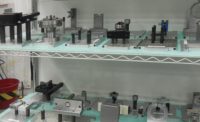If you’ve ever wondered how your company’s spending patterns compare to others, we here at Quality Magazine aim to help.
Our 14th Annual Spending Survey examines current and future trends in manufacturing spending on quality-related equipment, software and services. The results of our survey examine how much respondents will be spending and what they plan to buy, as well as how this compares to previous years.
And the results offer reason for optimism: According to this year’s survey, 57% of respondents said that quality is “somewhat” or “much more important” than a year ago.
But while the importance of quality may be on the rise, the budget may not be. The survey found that 73% of respondents expect fiscal year 2013 spending to mirror 2012. And looking ahead to 2014, about half (51%) expected 2014 spending to be the same as 2013, while 39% expect their spending next year to increase, and by about 24%. The top three reasons for an increase in spending are: reducing scrap and rework (61%), improving productivity (59%), and increasing production capacity (54%). Other top reasons for investment include reducing costs and tightening part quality standards.
These reasons have changed from last year, as tightening part quality standards and complying with ISO were rated as less important, while enhancing machine and process flexibility was rated more important.
With the projected spending increases, more than half of respondents said they plan to buy gages and gaging systems; general use test, measurement and inspection equipment; and test, measurement and inspection services.
A Look at Respondents
The mean company size this year was 428 employees. In terms of respondents, 38% came from the Midwest, 26% from the South, 19% from the Northeast, and 17% from the West.
This year, the largest number of respondents worked in the aerospace field, with 21% manufacturing aerospace parts and products, followed by fabricated metal product manufacturing at 16%, and medical equipment and supply manufacturing at 9%. Other manufacturing work included motor vehicle body, trailer and parts; plastics and rubber parts; electrical equipment, appliances and components; and machinery.
As for the respondents themselves, 45% categorized their job function as quality management, 24% as quality engineering, 8% as engineering/technical, 7% as corporate management, 6% as manufacturing engineering, 6% as manufacturing management/operations, 1% as purchasing, 1% as research and development, and 3% as other.
The Importance of Quality
Quality continues to matter. Compared to a year ago, 26% of respondents said it was much more important, 31% said it was somewhat more important, and 40% said it was about the same. Only 2% said it was somewhat less important and just 1% said it was much less important. These responses are similar to those from last year.
When asked how actual fiscal year 2012 spending compared to the budgeted amount set in 2011, 64% said it was the same as projected. Nineteen percent of respondents reported being over budget, and 17% said they were under budget. Of those that reported being over budget, the mean amount over budget was 19%, close to last year’s response of 21%. For those who reported being under budget, the mean amount under budget was 23%, similar to the 25% under budget reported last year.
When looking at this fiscal year’s actual spending vs. projected, the majority of respondents (73%) spent as expected. Sixteen percent came in over budget, with a mean amount over budget of 23%, as compared to the 20% over budget reported last year.
Eleven percent reported being under budget, by a mean of 23% under, which was the same as last year.
Looking ahead to next year, about half (51%) expect spending in the fiscal year 2014 to match 2013. This closely matches the 48% response of last year.
Thirty-nine percent expect their projected spending to increase, and by a mean amount of about 24%. This parallels the 40% who expected an increase last year by a mean amount of 22%.
Eleven percent expect a decrease in spending, by a mean of 18%. Last year 12% of respondents expected a decrease, at a mean of 33%.
Inspection Approach
While inspection equipment matters, it also makes sense to look at the inspection methods. This year, for incoming inspection, 11% reported no sampling, 24% did random sampling, 55% did lot sampling, and 10% inspected every part or product. These numbers roughly parallel those from 2010-2012, with lot sampling accounting for the majority of inspection.
For in-process inspection, 4% did no sampling, 28% did random sampling, 38% did lot sampling, and 30% inspected every product. This distribution is similar to that of the past three years.
The inspection process changes for final inspection. Only 1% said they did no sampling, 16% did random sampling, 37% did lot sampling, and almost half, at 46%, inspected every part or product.
What They Plan to Buy
Gages and gaging systems top the list of purchases planned for next year, with 67% planning to buy them, up from 52% last year. Gages were followed by general use test, measurement and inspection equipment (such as calibration equipment or laser systems), with 63% planning to purchase these, up from 41% last year. About half (52%) plan to purchase test, measurement and inspection services. Thirty-six percent expressed interest in purchasing product testing equipment, 35% in software, 34% in consulting, and 31% in optical inspection and measurement equipment. Equipment for nondestructive testing came in at 27%, materials testing at 24%, form and surface measurement at 21%, CMMs at 14%, and color and coating thickness measurement at 10%. Only 11% said they did not plan to purchase any of this equipment.
In looking at the planned average equipment budget, the CMM budget spiked this year, jumping to $119,829 from $82,895.
The planned budget for many other categories grew as well, including form and surface inspection equipment, gages and gaging systems, optical inspection and measurement equipment, color testing, and product testing.
The mean budget for CMMs this year came out to $63,724. Forty-two percent expected their CMM budget to increase in 2014, while 29% expected it to remain the same and 30% expected it to decrease.
The mean budget for form and surface measurement equipment came out to just under $32,000. About half (46%) expected this to increase next year, while the other half (48%) expected it to remain the same. Just 5% expected a decrease.
The fiscal year budget for gages was $40,419 this year. Sixty-four percent expect this to remain the same next year, 21% expect an increase, and 15% expect a decrease. Handheld measuring tools such as calipers, micrometers and indicators are the top priority, taking 34% of the expected gages budget.
A mean of $32,305 was budgeted for optical inspection and measurement equipment this year, a jump from the mean of $22,684 last year. About half (49%) expect this to remain the same next year, 42% expect an increase, and 10% a decrease. Optical comparators top the list, taking 28% of the planned budget.
For product testing equipment, the mean amount budgeted was $42,086, a drop from last year’s $66,348. For fiscal year 2014, more than half (56%) expect this to remain the same, while 26% expect an increase, and 18%, a decrease.
The materials test equipment mean budget for this year was $23,849, a drop from last year’s mean of $46,236. Respondents were split between the projected materials test budget for next year. Half expected an increase, 49% expected it to remain the same, and the remaining 1% expected a decrease.
The budget for nondestructive test equipment came out to a mean of $20,124, close to last year’s mean of $19,989. Fifty-one percent expect results to remain the same in fiscal year 2014, while 44% expect an increase and 4% a decrease.
The general use test, measurement and inspection equipment budget for this year came out to a mean of $26,332, a drop from last year’s $37,526. The majority (70%) expect the spending for next year to remain the same, while 18% anticipate an increase, and 13%, a decrease.
The software budget for this year, $14,325, has remained largely consistent with last year’s mean of $14,172. Slightly more than half (54%) expect this to remain the same for next year, while 31% anticipate an increase. Fourteen percent expect a decrease.
In terms of consulting and training services, the mean amount spent was $33,917, an increase from last year’s $25,506. Sixty-three percent expect this to remain the same for next year, 28% expect an increase, and only 9% expect a decrease.
As for test, measurement and inspection services—such as calibration, contract part inspection, and environmental testing—respondents indicated a budget with a mean of $31,718 for this year, an increase from the mean of $27,228 last year. The majority (73%) expect this to remain the same for next year, while 17% expect an increase and 10%, a decrease.
Methodology
The survey was sent to 19,808 active, qualified Quality subscribers. Responses were fielded from August 1-19, and October 7-11. The response rate was 2%. Data was weighted to match Quality’s BPA regional distribution to be representative of its professionals. BNP Media’s Market Research Division conducted the survey with Quality, and we would like to thank all those who participated.
Michelle Bangert is the managing editor of Quality magazine.
| Tech Tips | ||||
|
The top three reasons for an increase in spending are: reducing scrap and rework, improving productivity, and increasing production capacity. More than half of respondents said they plan to buy gages and gaging systems; general use test, measurement and inspection equipment; and test, measurement and inspection services. When looking at this fiscal year’s actual spending vs. projected, 73% of respondents said they spent as expected. |
||||













